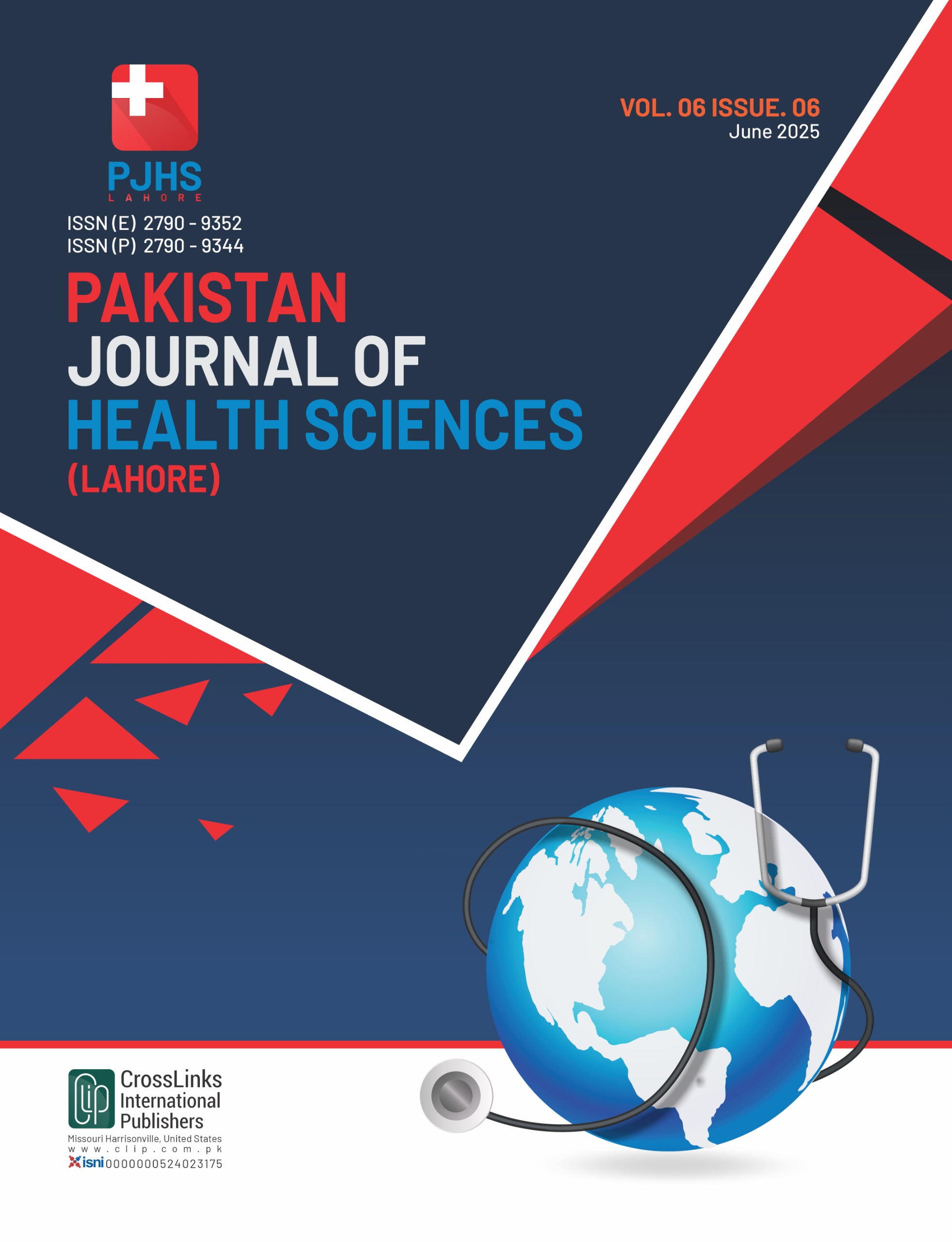Changes in Blood Pressure and Pulse Rate in Patients Following the Injection of Lidocaine with 2% Adrenaline in A Mandibular Nerve Block
Blood Pressure: Lidocaine with 2% Adrenaline in A Mandibular Nerve Block
DOI:
https://doi.org/10.54393/pjhs.v6i6.2416Keywords:
Blood Pressure, Pulse Rate, Lidocaine, Mandibular Nerve BlockAbstract
Local anaesthetic like lidocaine are commonly used in dental and maxillofacial procedures, but their systemic vasoconstrictive effects can cause physiological changes, especially in cardiovascular parameters. Objectives: To evaluate the blood pressure and pulse rate alterations in patients after administering a mandibular nerve block using 2% lidocaine with adrenaline. Methods: Three hundred patients aged 14-60 who came for extraction were selected through non-probability consecutive sampling. Clinical examinations were performed, and diastolic, systolic blood pressure, and pulse rate were recorded with an automatic digital blood pressure monitor in four stages (before local anesthesia (5 minutes’ rest), before local anesthesia (sitting at chair), after local anesthesia (immediate) and after local anesthesia (10 minutes)). Results: A study of 300 mandibular nerve block patients found that male patients (69.3%) and female patients (30.7%) had a mean age of 32.95 ± 11.19 years. Blood pressure, pulse rate, and oxygen saturation significantly varied in all four stages. In the first stage, most patients had normal blood pressure (120/80 mmHg), while in stages 2-4, most had stage 1 blood pressure (139/89 mmHg). In stages 3 and 4, patients had stage 2 blood pressure (140/90 mmHg), and in stage 4, 1.3% experienced hypertensive crisis. In stages 1-4, most patients had normal pulse rate, followed by tachycardia and bradycardia. Conclusions: The study found significant differences in blood pressure and pulse rate among patients after administration of a mandibular nerve block using 2% lidocaine with adrenaline.
References
Güler S, Könemann H, Wolfes J, Güner F, Ellermann C, Rath B et al. Lidocaine as an anti‐arrhythmic drug: Are there any indications left? Clinical and Translational Science. 2023 Dec; 16(12): 2429-37. doi: /10.1111/cts.13650. DOI: https://doi.org/10.1111/cts.13650
Macfarlane AJ, Gitman M, Bornstein KJ, El‐Boghdadly K, Weinberg G. Updates in our understanding of local anaesthetic systemic toxicity: a narrative review. Anesthesia. 2021 Jan; 76: 27-39. doi: 10.1111/anae.15282. DOI: https://doi.org/10.1111/anae.15282
Choi DY and Hur MS. Anatomical review of the mandibular lingula for inferior alveolar nerve block. Folia Morphological. 2021; 80(4): 786-91. doi: 10.5603/FM.a2020.0135. DOI: https://doi.org/10.5603/FM.a2020.0135
Deshpande N, Jadhav A, Bhola ND, Gupta M, Bhola N. The Comparative Evaluation of the Anesthetic Efficacy of 4% Articaine with 1: 100,000 Adrenaline and 0.75% Ropivacaine for Inferior Alveolar Nerve Block in the Extraction of Impacted Lower Third Molar. Cureus. 2022 Sep; 14(9). doi: 10.7759/cureus.29639. DOI: https://doi.org/10.7759/cureus.29639
Aggarwal V, Singla M, Saatchi M, Gupta A, Hasija M, Meena B. Effect of cooling of lidocaine with epinephrine on the anesthetic success of supplementary intraligamentary injection after a failed primary inferior alveolar nerve block: a randomized controlled trial. European Endodontic Journal. 2023; 8(4): 239. doi: 10.14744/eej.2023.41275. DOI: https://doi.org/10.14744/eej.2023.41275
Beutler K, Bijata B, Burek D, Paszkowska A, Kujawa A, Matuszewska U et al. How to deal with pain in the emergency department-pain management review. Journal of Education, Health and Sport. 2024 Jan; 51: 155-65. doi: 10.12775/JEHS.2024.51.012. DOI: https://doi.org/10.12775/JEHS.2024.51.012
Ping B, Kiattavorncharoen S, Durward C, Im P, Saengsirinavin C, Wongsirichat N. Hemodynamic changes associated with a novel concentration of lidocaine HCl for impacted lower third molar surgery. Journal of Dental Anesthesia and Pain Medicine. 2015 Sep; 15(3): 121-8. doi: 10.17245/jdapm.2015.15.3.121. DOI: https://doi.org/10.17245/jdapm.2015.15.3.121
Khalid A, Khan MA, Punjabi SK, Manzoor U, Aslam MA, Shams S. Evaluation of anxiety and hemodynamic changes in surgical removal of lower third molar under local anesthesia. The Professional Medical Journal. 2024; 31(01): 78-83. doi: 10.29309/TPMJ/2024.31.01.7886. DOI: https://doi.org/10.29309/TPMJ/2024.31.01.7886
Managutti A, Prakasam M, Puthanakar N, Menat S, Shah D, Patel H. Comparative analysis of local anesthesia with 2 different concentrations of adrenaline: a randomized and single blind study. Journal of International Oral Health. 2015 Mar; 7(3): 24.
Gadve VR, Shenoi R, Vats V, Shrivastava A. Evaluation of anxiety, pain, and hemodynamic changes during surgical removal of lower third molar under local anesthesia. Annals of Maxillofacial Surgery. 2018 Jul; 8(2): 247-53. doi: 10.4103/ams.ams_216_18. DOI: https://doi.org/10.4103/ams.ams_216_18
Horvath B, Kloesel B, Todd MM, Cole DJ, Prielipp RC. The evolution, current value, and future of the American Society of Anesthesiologists Physical Status Classification System. Anesthesiology. 2021 Oct; 135(5): 904-19. doi: 10.1097/ALN.0000000000003947. DOI: https://doi.org/10.1097/ALN.0000000000003947
Ali FM, Iryani GM, Bakri MM, Halawi S, Mashyakhi E, Darraj O. Evaluation of changes in Blood Pressure (BP) and Heart Rate (HR) among controlled Hypertensive and Normotensive Patients before and after receiving Dental Local Anesthesia (DLA) with Adrenaline: A Prospective Study. Biomedical and Pharmacology Journal. 2022 Jun; 15(2): 757-66. doi: 10.13005/bpj/2413. DOI: https://doi.org/10.13005/bpj/2413
Davoudi A, Rismanchian M, Akhavan A, Nosouhian S, Bajoghli F, Haghighat A et al. A brief review on the efficacy of different possible and nonpharmacological techniques in eliminating discomfort of local anesthesia injection during dental procedures. Anesthesia Essays and Research. 2016 Jan; 10(1): 13-6. doi: 10.4103/0259-1162.167846. DOI: https://doi.org/10.4103/0259-1162.167846
Dixit A, Randhawa RK, Randhawa GS, Solanki P, Takvani R, Vaghela I. Comparative analysis of local anesthetic techniques for pain Management in Pediatric Dental Procedures: a randomized clinical trial. Journal of Pharmacy and Bio-allied Sciences. 2024 Feb; 16(Suppl 1): S196-8. doi: 10.4103/jpbs.jpbs_454_23. DOI: https://doi.org/10.4103/jpbs.jpbs_454_23
St George G, Morgan A, Meechan J, Moles DR, Needleman I, Ng YL et al. Injectable local anaesthetic agents for dental anesthesia. Cochrane Database of Systematic Reviews. 2018(7). doi: 10.1002/14651858.CD006487.pub2. DOI: https://doi.org/10.1002/14651858.CD006487.pub2
Caviedes-Bucheli J, Rojas P, Escalona M, Estrada A, Sandoval C, Rivero C et al. The effect of different vasoconstrictors and local anesthetic solutions on substance P expression in human dental pulp. Journal of Endodontics. 2009 May; 35(5): 631-3. doi: 10.1016/j.joen.2008.12.020. DOI: https://doi.org/10.1016/j.joen.2008.12.020
Deo SP. Role of addition of dexamethasone to lignocaine 2% with adrenaline in dental nerve blocks for third molar surgery: A prospective randomized control trial. Annals of Maxillofacial Surgery. 2016 Jul; 6(2): 260-6. doi: 10.4103/2231-0746.200341. DOI: https://doi.org/10.4103/2231-0746.200341
Chowdhury S, Singh M, Shah A. Efficacy of lignocaine with clonidine and adrenaline in minor oral surgical procedure. Contemporary Clinical Dentistry. 2012 Apr; 3(2): 227-9. doi: 10.4103/0976-237X.96839. DOI: https://doi.org/10.4103/0976-237X.96839
Brkovic B, Todorovic L, Stojic D. Comparison of clonidine and epinephrine in lidocaine anesthesia for lower third molar surgery. International Journal of Oral and Maxillofacial Surgery. 2005 Jun; 34(4): 401-6. doi: 10.1016/j.ijom.2004.06.014. DOI: https://doi.org/10.1016/j.ijom.2004.06.014
Aliabadi E, Divanpour V, Mardani M. Changes in blood pressure and pulse rate of patients without systemic diseases following the injection of 2% lidocaine plus epinephrine 1: 80000 in an inferior alveolar nerve block-a prospective study. Annals of Maxillofacial Surgery. 2020 Jul; 10(2): 361-4. doi: 10.4103/ams.ams_187_19. DOI: https://doi.org/10.4103/ams.ams_187_19
Downloads
Published
How to Cite
Issue
Section
License
Copyright (c) 2025 Pakistan Journal of Health Sciences

This work is licensed under a Creative Commons Attribution 4.0 International License.
This is an open-access journal and all the published articles / items are distributed under the terms of the Creative Commons Attribution License, which permits unrestricted use, distribution, and reproduction in any medium, provided the original author and source are credited. For comments













